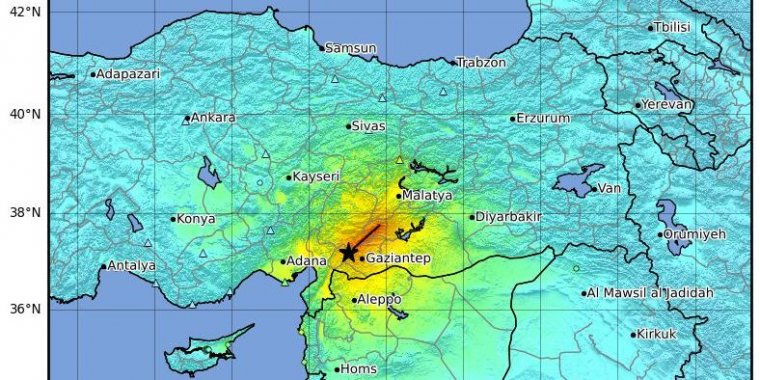| News / World News |
Turkey–Syria earthquakes
On 6 February 2023, two powerful earthquakes struck southern and central Turkey. The first occurred 34 km (21 mi) west of the city of Gaziantep at 04:17 TRT (01:17 UTC), causing widespread damage in Turkey and Syria.

2023 Turkey–Syria earthquakes. Photo: USGS
With a maximum Mercalli intensity of IX (Violent) and a magnitude of Mww 7.8, the first earthquake is tied with the 1939 Erzincan earthquake as the strongest instrumentally recorded earthquake to hit Turkey in modern times, while possibly being surpassed by the 1668 North Anatolia earthquake. It is also the most devastating earthquake to strike the country since the 1999 İzmit earthquake.
The earthquake was followed by numerous aftershocks, the strongest of which had a magnitude of Mw 6.7.
The second earthquake occurred 9 hours later, 4 km (2.5 mi) south–southeast of Ekinözü in Kahramanmaraş Province at 13:24 TRT (10:24 UTC), also having a maximum Mercalli intensity of IX and a magnitude of Mww 7.5.
As a result of the earthquakes, more than 9,800 deaths have been reported in total; 7,108 were killed in Turkey and 2,547 in Syria. More than 44,000 were injured.
The United States Geological Survey (USGS) measured the first earthquake at moment magnitude (Mww ) 7.8, striking at 01:17 UTC. It had an epicenter 34 km (21 mi) west of Gaziantep in Gaziantep Province, which is near the border with Syria.
A second earthquake measuring Mww 7.5 struck at 10:24 UTC with an epicenter 4 km (2.5 mi) south–southeast of Ekinözü in Kahramanmaraş Province. It was followed by a mb 6.0 aftershock.
The first earthquake had an aftershock measuring Mww 6.7 which occurred about 11 minutes after the mainshock. There were 25 aftershocks Mw 4.0 or greater recorded within six hours of the main tremor, according to the USGS.
More than 12 hours later, the USGS had reported at least 54 aftershocks of 4.3 or greater magnitude, while the Turkish Disaster and Emergency Management Presidency (AFAD) recorded at least 120 aftershocks. Tremors from the two mainshocks were detected as far away as Greenland.
In total, around 11,302 buildings collapsed in ten provinces across Turkey. Many buildings were destroyed in Adıyaman and Diyarbakır. In Diyarbakır, a shopping mall collapsed.
About 300 building collapses also occurred in Malatya. A well-known 13th century mosque in the province partially collapsed. The ancient Gaziantep Castle was seriously damaged. Fires broke out all over the region.
In Hatay Province, the runway of Hatay Airport was split and uplifted.
The opposition Syrian Civil Defence called the situation in the northwest part of the country "disastrous". Many buildings collapsed and people were trapped.
Collapses occurred in the cities of Aleppo, Latakia, and Hama. The Crusader-built castle Margat suffered damage, with part of a tower and parts of some walls collapsing. The Citadel of Aleppo was also affected.
The European-Mediterranean Seismological Centre said shaking was felt in Armenia, Egypt, Georgia, Greece, Iraq, Israel, Jordan, Palestine, Romania, and Greenland.
Three aircraft of the Romanian Air Force that have on board teams specialized in search and rescue interventions of the General Inspectorate for Emergency Situations of Romania (IGSU) and SMURD medical teams, consisting of 60 members, 4 rescue dogs, and related specialized equipment, left for Turkey on 6 February following the disaster. (Wikipedia)
YOU MAY ALSO LIKE





